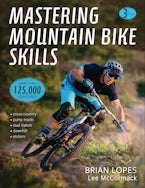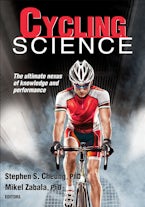- Home
- Anatomy
- Sports and Activities
- Cycling and Mountain Biking
- Cycling Anatomy
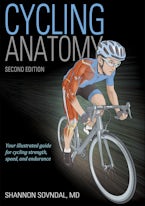
Using the same methods that elite cyclists use, you can employ this well-rounded collection of 89 strength and conditioning exercises to maximize cycling power, speed, and endurance to improve your cycling performance. Each exercise includes clear step-by-step descriptions and full-color anatomical illustrations that highlight the primary muscle being used. You’ll find dozens of variations that use a wide range of training equipment so you can modify exercises to target specific areas, and minimize common cycling injuries.
The Cycling Focus section of each exercise includes illustrations of the active muscles involved in cornering, climbing, descending, and sprinting to show you how the exercises are fundamentally linked to delivering maximum power to the pedals. Using tried-and-true strength training principles for all parts of the body, Cycling Anatomy will help you develop a training plan based on your individual needs and goals.
Whether you’re training for an upcoming century ride or just want to top that killer hill with strength to spare, Cycling Anatomy will help you reach top performance, avoid injury, and ensure you get the most out of every ride.
Chapter 2. Strength Training Principles
Chapter 3. Arms
Chapter 4. Shoulders and Neck
Chapter 5. Chest
Chapter 6. Back
Chapter 7. Core
Chapter 8. Leg Isolation
Chapter 9. Leg Complete Power
Chapter 10. Whole-Body Training for Cycling
Shannon Sovndal, MD, FACEP, is a board-certified emergency physician and a fellow of the American College of Emergency Physicians (ACEP). He attended medical school at Columbia University in New York and completed a residency in emergency medicine at Stanford University.
Sovndal’s ties to elite-level cycling run deep: He was a team physician for the Garmin-Sharp Professional Cycling Team for seven years, has worked most every major race in Europe and the United States, and has written two books on cycling (Cycling Anatomy and Fitness Cycling). He founded Thrive HFM (Health–Fitness–Medicine) in 2005, an elite-level training business through which he offers personalized and interactive sports training and wellness management.
Sovndal has worked extensively in prehospital medical care, including EMS, fire service, and tactical medicine. He currently is the medical director for Med Evac (Rotor Wing Service) and multiple fire departments in Colorado. He is a state-certified fire fighter and provides care for the Denver FBI Tactical Team. He serves on the board of directors for the Association of Air Medical Services (AAMS) and is the medical director for the Rocky Mountain Tactical Team Association (RMTTA).
Sovndal lives in Colorado with his wife, Stephanie, and four children, Soren, Theron, Saveah, and Elias.
“With detailed anatomical illustrations accompanying each exercise, Cycling Anatomy allows you to see and understand exactly what muscles you’re training. This book will give you the knowledge you need to minimize injuries and maximize power on the bike.”
—Alex Howes, WorldTour Professional Cyclist and Two-Time Tour de France Finisher
“Cycling Anatomy is full of the most effective exercises that cyclists of any level can use to improve their training and enhance their performance.”
—Christian Vande Velde, Professional Cyclist, NBC Cycling Analyst, and Two-Time Olympian
Around the world weight plate exercise
Place your feet shoulder-width apart and hold a weight plate in both hands with arms extended in front of you.
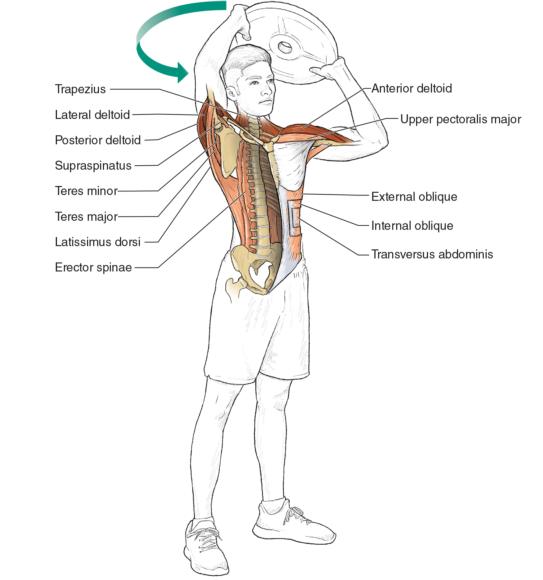
Execution
- Place your feet shoulder-width apart and hold a weight plate in both hands with arms extended in front of you.
- In a circular motion, orbit the weight around your head, completing a 360-degree revolution and ending up at the starting position.
- Complete the same motion in the reverse direction, again ending at your starting point.
Muscles Involved
Primary: Anterior, lateral, and posterior deltoids; trapezius
Secondary: Upper pectoralis major, supraspinatus, infraspinatus, teres minor, teres major, rhomboids, latissimus dorsi, transversus abdominis, external and internal obliques, erector spinae (iliocostalis, longissimus, spinalis)
Cycling Focus
This exercise hits nearly every muscle group of your shoulders and arms. I like including this in my workouts because it is efficient, working many muscle groups in one exercise. Imagine shifting your mountain bike back and forth to avoid terrain, all the while applying acceleration to summit the top of a climb. This exercise is fluid, like riding your bike. Microadjustments while performing powerful, sweeping movements will help stabilize your shoulders in addition to building power in the larger muscle groups.
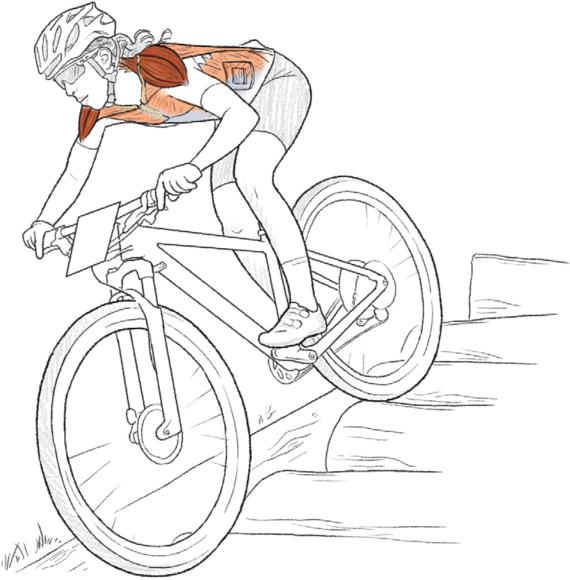
Variation
Around the World on a Half Dome Balance Trainer
Standing on the unstable surface will help build core and back strength. It will also help strengthen the stabilizer muscles in your legs and buttocks.
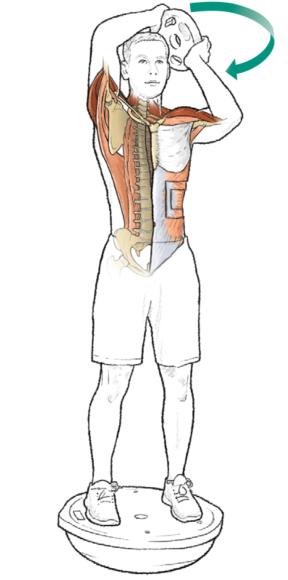
Adaptation as the basis for weight training
The general adaptation syndrome (GAS) provides the fundamental construct for conditioning and weight training. Developed and published in 1950 (Selye 1950), it remains a fundamental paradigm today.
Adaptation
The general adaptation syndrome (GAS) provides the fundamental construct for conditioning and weight training. Developed and published in 1950 (Selye 1950), it remains a fundamental paradigm today. I recommend reading the original article. The GAS is made up of three phases: alarm reaction, adaptation, and exhaustion. The human body likes to maintain homeostasis. It constantly works to resist change and remain at rest. Every time the body experiences a new stress—such as a longer-than-normal bike ride or weightlifting—the body becomes “alarmed.” The stressor disturbs the natural homeostasis and moves the body out of its comfort zone. Phase 2 occurs when the body tries to mitigate the stress by adapting to it. The body will reach a new, higher level of homeostasis as a result of the adaptation. Ideally, as you train, you'll repeat phases 1 and 2 to continually improve your level of strength and fitness (figure 2.1).
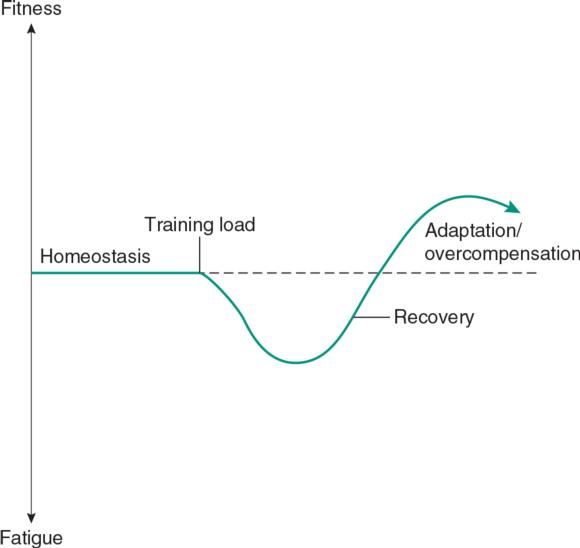
Figure 2.1 General adaptation syndrome. Your body is initially in a state of homeostasis. An alarm reaction or training load induces a level of fatigue. Your body responds to the stress, first through recovery and then adaptation.
Reprinted by permission from S. Sovndal, Fitness Cycling (Champaign, IL: Human Kinetics, 2013), 9.
If you overdo it, however, you may overwhelm your body's adaptive abilities. This will cause you to reach the third phase of the GAS: exhaustion. You'll find that your training is a fine balance of stress and recovery. I like using the analogy of roasting marshmallows at a campfire. I learned this from my good friend and founder of Skratch Labs, Dr. Allen Lim. Applying stimulus is like heat to the marshmallow. The right amount of heat and the marshmallow becomes soft, brown and delicious. Too much heat, like overtraining, and the marshmallow begins to burn (figure 2.2).
Looking at this model—alarm reaction, adaptation, and exhaustion—you can see the importance of the RACE training philosophy. You need rest to avoid overtraining and exhaustion. Only by being accountable and consistent can you have adaptation through your training. Be sure to allow yourself adequate rest between workouts. Remember, adaptation and conditioning come while you are resting and recovering, not while you are working out.
Periodization (figure 2.3) is another key training concept that goes hand in hand with the GAS. All training should be based on a well-planned, systematic, and stepwise approach that involves training cycles or blocks being built one on top of the other. This hierarchical structure continually builds on previous gains while giving the body time to adapt and condition. A good periodization program will enable you to avoid overtraining and to continually increase your fitness level. Think of the periodization program as the big picture of your training. The program will help you work toward particular points in time when you want to be at peak fitness. The training blocks can vary in length, but they will usually range between two and four weeks. As you use this book to plan your various workouts, you should choose different exercises during each block in an effort to continually “alarm” your system. This is the best way to improve your strength and conditioning.
Suspension pike exercise
Get into a push-up position with your feet in the suspension strap handles.
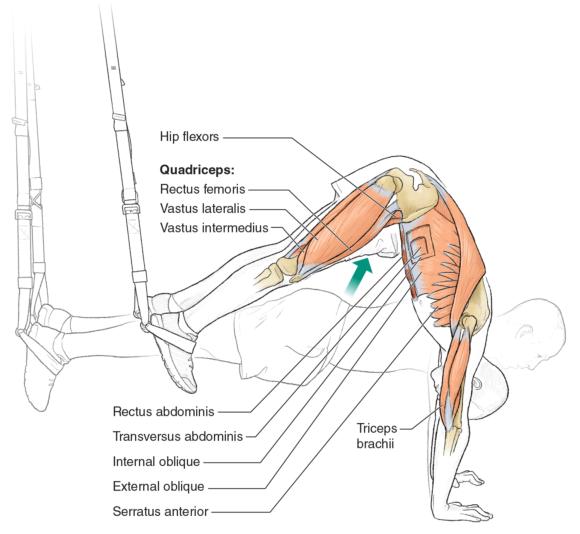
Execution
- Get into a push-up position with your feet in the suspension strap handles.
- Lift your hips upward into a pike position. Your feet will move toward your hands, which are planted on the floor.
- Keep your back and legs straight during the entire exercise.
- Return to the starting position.
Muscles Involved
Primary: Rectus abdominis
Secondary: External oblique, internal oblique, transversus abdominis, serratus anterior, sartorius, iliopsoas, hip flexors, tensor fasciae latae, pectineus, adductor brevis, adductor longus, quadriceps (rectus femoris, vastus lateralis, vastus medialis, vastus intermedius), triceps brachii, latissimus dorsi, teres major, posterior deltoid
Cycling Focus
This exercise is terrific for cyclists. It works core stability as well as the abdominal muscles, quadriceps, arms, and shoulders. Because the straps can freely move, you will be forced to use all your secondary stabilizing muscles to maintain good form. These are the same muscles that will help you with your riding form when you become fatigued. When riding, your key foundation points will be your arms on the handlebars and your feet on the pedals. This exercise trains the same muscles. You'll be amazed at how tough this exercise is and definitely will notice improvement once you hit the road. Focus on controlled inhalation and exhalation throughout the entire range of motion. When riding your bike, you must continue controlled breathing even during tough efforts. Without the delivery of new oxygen to the muscles—and the removal of carbon dioxide from the muscles—you'll soon lose power and the ability to rotate the cranks.
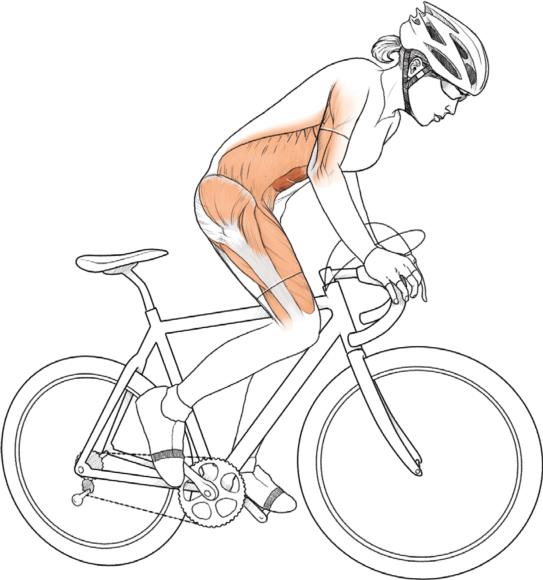
Variation
Stability Ball Pike
Perform the same exercise, but instead of using the suspension straps, place your feet on top of a stability ball. This is a great alternative if you don't have access to suspension straps. The ball offers similar instability, which is a key component of this exercise.
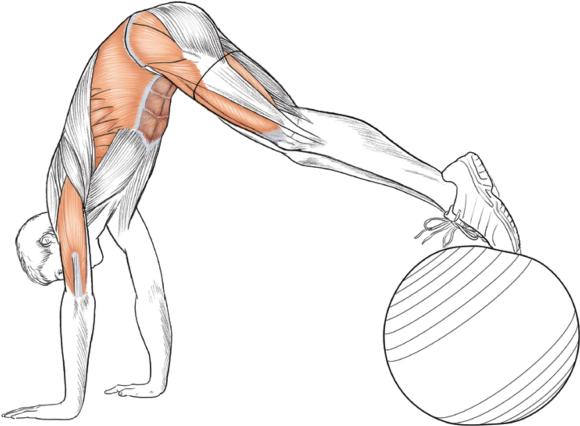
Around the world weight plate exercise
Place your feet shoulder-width apart and hold a weight plate in both hands with arms extended in front of you.

Execution
- Place your feet shoulder-width apart and hold a weight plate in both hands with arms extended in front of you.
- In a circular motion, orbit the weight around your head, completing a 360-degree revolution and ending up at the starting position.
- Complete the same motion in the reverse direction, again ending at your starting point.
Muscles Involved
Primary: Anterior, lateral, and posterior deltoids; trapezius
Secondary: Upper pectoralis major, supraspinatus, infraspinatus, teres minor, teres major, rhomboids, latissimus dorsi, transversus abdominis, external and internal obliques, erector spinae (iliocostalis, longissimus, spinalis)
Cycling Focus
This exercise hits nearly every muscle group of your shoulders and arms. I like including this in my workouts because it is efficient, working many muscle groups in one exercise. Imagine shifting your mountain bike back and forth to avoid terrain, all the while applying acceleration to summit the top of a climb. This exercise is fluid, like riding your bike. Microadjustments while performing powerful, sweeping movements will help stabilize your shoulders in addition to building power in the larger muscle groups.

Variation
Around the World on a Half Dome Balance Trainer
Standing on the unstable surface will help build core and back strength. It will also help strengthen the stabilizer muscles in your legs and buttocks.

Adaptation as the basis for weight training
The general adaptation syndrome (GAS) provides the fundamental construct for conditioning and weight training. Developed and published in 1950 (Selye 1950), it remains a fundamental paradigm today.
Adaptation
The general adaptation syndrome (GAS) provides the fundamental construct for conditioning and weight training. Developed and published in 1950 (Selye 1950), it remains a fundamental paradigm today. I recommend reading the original article. The GAS is made up of three phases: alarm reaction, adaptation, and exhaustion. The human body likes to maintain homeostasis. It constantly works to resist change and remain at rest. Every time the body experiences a new stress—such as a longer-than-normal bike ride or weightlifting—the body becomes “alarmed.” The stressor disturbs the natural homeostasis and moves the body out of its comfort zone. Phase 2 occurs when the body tries to mitigate the stress by adapting to it. The body will reach a new, higher level of homeostasis as a result of the adaptation. Ideally, as you train, you'll repeat phases 1 and 2 to continually improve your level of strength and fitness (figure 2.1).

Figure 2.1 General adaptation syndrome. Your body is initially in a state of homeostasis. An alarm reaction or training load induces a level of fatigue. Your body responds to the stress, first through recovery and then adaptation.
Reprinted by permission from S. Sovndal, Fitness Cycling (Champaign, IL: Human Kinetics, 2013), 9.
If you overdo it, however, you may overwhelm your body's adaptive abilities. This will cause you to reach the third phase of the GAS: exhaustion. You'll find that your training is a fine balance of stress and recovery. I like using the analogy of roasting marshmallows at a campfire. I learned this from my good friend and founder of Skratch Labs, Dr. Allen Lim. Applying stimulus is like heat to the marshmallow. The right amount of heat and the marshmallow becomes soft, brown and delicious. Too much heat, like overtraining, and the marshmallow begins to burn (figure 2.2).
Looking at this model—alarm reaction, adaptation, and exhaustion—you can see the importance of the RACE training philosophy. You need rest to avoid overtraining and exhaustion. Only by being accountable and consistent can you have adaptation through your training. Be sure to allow yourself adequate rest between workouts. Remember, adaptation and conditioning come while you are resting and recovering, not while you are working out.
Periodization (figure 2.3) is another key training concept that goes hand in hand with the GAS. All training should be based on a well-planned, systematic, and stepwise approach that involves training cycles or blocks being built one on top of the other. This hierarchical structure continually builds on previous gains while giving the body time to adapt and condition. A good periodization program will enable you to avoid overtraining and to continually increase your fitness level. Think of the periodization program as the big picture of your training. The program will help you work toward particular points in time when you want to be at peak fitness. The training blocks can vary in length, but they will usually range between two and four weeks. As you use this book to plan your various workouts, you should choose different exercises during each block in an effort to continually “alarm” your system. This is the best way to improve your strength and conditioning.
Suspension pike exercise
Get into a push-up position with your feet in the suspension strap handles.

Execution
- Get into a push-up position with your feet in the suspension strap handles.
- Lift your hips upward into a pike position. Your feet will move toward your hands, which are planted on the floor.
- Keep your back and legs straight during the entire exercise.
- Return to the starting position.
Muscles Involved
Primary: Rectus abdominis
Secondary: External oblique, internal oblique, transversus abdominis, serratus anterior, sartorius, iliopsoas, hip flexors, tensor fasciae latae, pectineus, adductor brevis, adductor longus, quadriceps (rectus femoris, vastus lateralis, vastus medialis, vastus intermedius), triceps brachii, latissimus dorsi, teres major, posterior deltoid
Cycling Focus
This exercise is terrific for cyclists. It works core stability as well as the abdominal muscles, quadriceps, arms, and shoulders. Because the straps can freely move, you will be forced to use all your secondary stabilizing muscles to maintain good form. These are the same muscles that will help you with your riding form when you become fatigued. When riding, your key foundation points will be your arms on the handlebars and your feet on the pedals. This exercise trains the same muscles. You'll be amazed at how tough this exercise is and definitely will notice improvement once you hit the road. Focus on controlled inhalation and exhalation throughout the entire range of motion. When riding your bike, you must continue controlled breathing even during tough efforts. Without the delivery of new oxygen to the muscles—and the removal of carbon dioxide from the muscles—you'll soon lose power and the ability to rotate the cranks.

Variation
Stability Ball Pike
Perform the same exercise, but instead of using the suspension straps, place your feet on top of a stability ball. This is a great alternative if you don't have access to suspension straps. The ball offers similar instability, which is a key component of this exercise.

Around the world weight plate exercise
Place your feet shoulder-width apart and hold a weight plate in both hands with arms extended in front of you.

Execution
- Place your feet shoulder-width apart and hold a weight plate in both hands with arms extended in front of you.
- In a circular motion, orbit the weight around your head, completing a 360-degree revolution and ending up at the starting position.
- Complete the same motion in the reverse direction, again ending at your starting point.
Muscles Involved
Primary: Anterior, lateral, and posterior deltoids; trapezius
Secondary: Upper pectoralis major, supraspinatus, infraspinatus, teres minor, teres major, rhomboids, latissimus dorsi, transversus abdominis, external and internal obliques, erector spinae (iliocostalis, longissimus, spinalis)
Cycling Focus
This exercise hits nearly every muscle group of your shoulders and arms. I like including this in my workouts because it is efficient, working many muscle groups in one exercise. Imagine shifting your mountain bike back and forth to avoid terrain, all the while applying acceleration to summit the top of a climb. This exercise is fluid, like riding your bike. Microadjustments while performing powerful, sweeping movements will help stabilize your shoulders in addition to building power in the larger muscle groups.

Variation
Around the World on a Half Dome Balance Trainer
Standing on the unstable surface will help build core and back strength. It will also help strengthen the stabilizer muscles in your legs and buttocks.

Adaptation as the basis for weight training
The general adaptation syndrome (GAS) provides the fundamental construct for conditioning and weight training. Developed and published in 1950 (Selye 1950), it remains a fundamental paradigm today.
Adaptation
The general adaptation syndrome (GAS) provides the fundamental construct for conditioning and weight training. Developed and published in 1950 (Selye 1950), it remains a fundamental paradigm today. I recommend reading the original article. The GAS is made up of three phases: alarm reaction, adaptation, and exhaustion. The human body likes to maintain homeostasis. It constantly works to resist change and remain at rest. Every time the body experiences a new stress—such as a longer-than-normal bike ride or weightlifting—the body becomes “alarmed.” The stressor disturbs the natural homeostasis and moves the body out of its comfort zone. Phase 2 occurs when the body tries to mitigate the stress by adapting to it. The body will reach a new, higher level of homeostasis as a result of the adaptation. Ideally, as you train, you'll repeat phases 1 and 2 to continually improve your level of strength and fitness (figure 2.1).

Figure 2.1 General adaptation syndrome. Your body is initially in a state of homeostasis. An alarm reaction or training load induces a level of fatigue. Your body responds to the stress, first through recovery and then adaptation.
Reprinted by permission from S. Sovndal, Fitness Cycling (Champaign, IL: Human Kinetics, 2013), 9.
If you overdo it, however, you may overwhelm your body's adaptive abilities. This will cause you to reach the third phase of the GAS: exhaustion. You'll find that your training is a fine balance of stress and recovery. I like using the analogy of roasting marshmallows at a campfire. I learned this from my good friend and founder of Skratch Labs, Dr. Allen Lim. Applying stimulus is like heat to the marshmallow. The right amount of heat and the marshmallow becomes soft, brown and delicious. Too much heat, like overtraining, and the marshmallow begins to burn (figure 2.2).
Looking at this model—alarm reaction, adaptation, and exhaustion—you can see the importance of the RACE training philosophy. You need rest to avoid overtraining and exhaustion. Only by being accountable and consistent can you have adaptation through your training. Be sure to allow yourself adequate rest between workouts. Remember, adaptation and conditioning come while you are resting and recovering, not while you are working out.
Periodization (figure 2.3) is another key training concept that goes hand in hand with the GAS. All training should be based on a well-planned, systematic, and stepwise approach that involves training cycles or blocks being built one on top of the other. This hierarchical structure continually builds on previous gains while giving the body time to adapt and condition. A good periodization program will enable you to avoid overtraining and to continually increase your fitness level. Think of the periodization program as the big picture of your training. The program will help you work toward particular points in time when you want to be at peak fitness. The training blocks can vary in length, but they will usually range between two and four weeks. As you use this book to plan your various workouts, you should choose different exercises during each block in an effort to continually “alarm” your system. This is the best way to improve your strength and conditioning.
Suspension pike exercise
Get into a push-up position with your feet in the suspension strap handles.

Execution
- Get into a push-up position with your feet in the suspension strap handles.
- Lift your hips upward into a pike position. Your feet will move toward your hands, which are planted on the floor.
- Keep your back and legs straight during the entire exercise.
- Return to the starting position.
Muscles Involved
Primary: Rectus abdominis
Secondary: External oblique, internal oblique, transversus abdominis, serratus anterior, sartorius, iliopsoas, hip flexors, tensor fasciae latae, pectineus, adductor brevis, adductor longus, quadriceps (rectus femoris, vastus lateralis, vastus medialis, vastus intermedius), triceps brachii, latissimus dorsi, teres major, posterior deltoid
Cycling Focus
This exercise is terrific for cyclists. It works core stability as well as the abdominal muscles, quadriceps, arms, and shoulders. Because the straps can freely move, you will be forced to use all your secondary stabilizing muscles to maintain good form. These are the same muscles that will help you with your riding form when you become fatigued. When riding, your key foundation points will be your arms on the handlebars and your feet on the pedals. This exercise trains the same muscles. You'll be amazed at how tough this exercise is and definitely will notice improvement once you hit the road. Focus on controlled inhalation and exhalation throughout the entire range of motion. When riding your bike, you must continue controlled breathing even during tough efforts. Without the delivery of new oxygen to the muscles—and the removal of carbon dioxide from the muscles—you'll soon lose power and the ability to rotate the cranks.

Variation
Stability Ball Pike
Perform the same exercise, but instead of using the suspension straps, place your feet on top of a stability ball. This is a great alternative if you don't have access to suspension straps. The ball offers similar instability, which is a key component of this exercise.

Around the world weight plate exercise
Place your feet shoulder-width apart and hold a weight plate in both hands with arms extended in front of you.

Execution
- Place your feet shoulder-width apart and hold a weight plate in both hands with arms extended in front of you.
- In a circular motion, orbit the weight around your head, completing a 360-degree revolution and ending up at the starting position.
- Complete the same motion in the reverse direction, again ending at your starting point.
Muscles Involved
Primary: Anterior, lateral, and posterior deltoids; trapezius
Secondary: Upper pectoralis major, supraspinatus, infraspinatus, teres minor, teres major, rhomboids, latissimus dorsi, transversus abdominis, external and internal obliques, erector spinae (iliocostalis, longissimus, spinalis)
Cycling Focus
This exercise hits nearly every muscle group of your shoulders and arms. I like including this in my workouts because it is efficient, working many muscle groups in one exercise. Imagine shifting your mountain bike back and forth to avoid terrain, all the while applying acceleration to summit the top of a climb. This exercise is fluid, like riding your bike. Microadjustments while performing powerful, sweeping movements will help stabilize your shoulders in addition to building power in the larger muscle groups.

Variation
Around the World on a Half Dome Balance Trainer
Standing on the unstable surface will help build core and back strength. It will also help strengthen the stabilizer muscles in your legs and buttocks.

Adaptation as the basis for weight training
The general adaptation syndrome (GAS) provides the fundamental construct for conditioning and weight training. Developed and published in 1950 (Selye 1950), it remains a fundamental paradigm today.
Adaptation
The general adaptation syndrome (GAS) provides the fundamental construct for conditioning and weight training. Developed and published in 1950 (Selye 1950), it remains a fundamental paradigm today. I recommend reading the original article. The GAS is made up of three phases: alarm reaction, adaptation, and exhaustion. The human body likes to maintain homeostasis. It constantly works to resist change and remain at rest. Every time the body experiences a new stress—such as a longer-than-normal bike ride or weightlifting—the body becomes “alarmed.” The stressor disturbs the natural homeostasis and moves the body out of its comfort zone. Phase 2 occurs when the body tries to mitigate the stress by adapting to it. The body will reach a new, higher level of homeostasis as a result of the adaptation. Ideally, as you train, you'll repeat phases 1 and 2 to continually improve your level of strength and fitness (figure 2.1).

Figure 2.1 General adaptation syndrome. Your body is initially in a state of homeostasis. An alarm reaction or training load induces a level of fatigue. Your body responds to the stress, first through recovery and then adaptation.
Reprinted by permission from S. Sovndal, Fitness Cycling (Champaign, IL: Human Kinetics, 2013), 9.
If you overdo it, however, you may overwhelm your body's adaptive abilities. This will cause you to reach the third phase of the GAS: exhaustion. You'll find that your training is a fine balance of stress and recovery. I like using the analogy of roasting marshmallows at a campfire. I learned this from my good friend and founder of Skratch Labs, Dr. Allen Lim. Applying stimulus is like heat to the marshmallow. The right amount of heat and the marshmallow becomes soft, brown and delicious. Too much heat, like overtraining, and the marshmallow begins to burn (figure 2.2).
Looking at this model—alarm reaction, adaptation, and exhaustion—you can see the importance of the RACE training philosophy. You need rest to avoid overtraining and exhaustion. Only by being accountable and consistent can you have adaptation through your training. Be sure to allow yourself adequate rest between workouts. Remember, adaptation and conditioning come while you are resting and recovering, not while you are working out.
Periodization (figure 2.3) is another key training concept that goes hand in hand with the GAS. All training should be based on a well-planned, systematic, and stepwise approach that involves training cycles or blocks being built one on top of the other. This hierarchical structure continually builds on previous gains while giving the body time to adapt and condition. A good periodization program will enable you to avoid overtraining and to continually increase your fitness level. Think of the periodization program as the big picture of your training. The program will help you work toward particular points in time when you want to be at peak fitness. The training blocks can vary in length, but they will usually range between two and four weeks. As you use this book to plan your various workouts, you should choose different exercises during each block in an effort to continually “alarm” your system. This is the best way to improve your strength and conditioning.
Suspension pike exercise
Get into a push-up position with your feet in the suspension strap handles.

Execution
- Get into a push-up position with your feet in the suspension strap handles.
- Lift your hips upward into a pike position. Your feet will move toward your hands, which are planted on the floor.
- Keep your back and legs straight during the entire exercise.
- Return to the starting position.
Muscles Involved
Primary: Rectus abdominis
Secondary: External oblique, internal oblique, transversus abdominis, serratus anterior, sartorius, iliopsoas, hip flexors, tensor fasciae latae, pectineus, adductor brevis, adductor longus, quadriceps (rectus femoris, vastus lateralis, vastus medialis, vastus intermedius), triceps brachii, latissimus dorsi, teres major, posterior deltoid
Cycling Focus
This exercise is terrific for cyclists. It works core stability as well as the abdominal muscles, quadriceps, arms, and shoulders. Because the straps can freely move, you will be forced to use all your secondary stabilizing muscles to maintain good form. These are the same muscles that will help you with your riding form when you become fatigued. When riding, your key foundation points will be your arms on the handlebars and your feet on the pedals. This exercise trains the same muscles. You'll be amazed at how tough this exercise is and definitely will notice improvement once you hit the road. Focus on controlled inhalation and exhalation throughout the entire range of motion. When riding your bike, you must continue controlled breathing even during tough efforts. Without the delivery of new oxygen to the muscles—and the removal of carbon dioxide from the muscles—you'll soon lose power and the ability to rotate the cranks.

Variation
Stability Ball Pike
Perform the same exercise, but instead of using the suspension straps, place your feet on top of a stability ball. This is a great alternative if you don't have access to suspension straps. The ball offers similar instability, which is a key component of this exercise.

Around the world weight plate exercise
Place your feet shoulder-width apart and hold a weight plate in both hands with arms extended in front of you.

Execution
- Place your feet shoulder-width apart and hold a weight plate in both hands with arms extended in front of you.
- In a circular motion, orbit the weight around your head, completing a 360-degree revolution and ending up at the starting position.
- Complete the same motion in the reverse direction, again ending at your starting point.
Muscles Involved
Primary: Anterior, lateral, and posterior deltoids; trapezius
Secondary: Upper pectoralis major, supraspinatus, infraspinatus, teres minor, teres major, rhomboids, latissimus dorsi, transversus abdominis, external and internal obliques, erector spinae (iliocostalis, longissimus, spinalis)
Cycling Focus
This exercise hits nearly every muscle group of your shoulders and arms. I like including this in my workouts because it is efficient, working many muscle groups in one exercise. Imagine shifting your mountain bike back and forth to avoid terrain, all the while applying acceleration to summit the top of a climb. This exercise is fluid, like riding your bike. Microadjustments while performing powerful, sweeping movements will help stabilize your shoulders in addition to building power in the larger muscle groups.

Variation
Around the World on a Half Dome Balance Trainer
Standing on the unstable surface will help build core and back strength. It will also help strengthen the stabilizer muscles in your legs and buttocks.

Adaptation as the basis for weight training
The general adaptation syndrome (GAS) provides the fundamental construct for conditioning and weight training. Developed and published in 1950 (Selye 1950), it remains a fundamental paradigm today.
Adaptation
The general adaptation syndrome (GAS) provides the fundamental construct for conditioning and weight training. Developed and published in 1950 (Selye 1950), it remains a fundamental paradigm today. I recommend reading the original article. The GAS is made up of three phases: alarm reaction, adaptation, and exhaustion. The human body likes to maintain homeostasis. It constantly works to resist change and remain at rest. Every time the body experiences a new stress—such as a longer-than-normal bike ride or weightlifting—the body becomes “alarmed.” The stressor disturbs the natural homeostasis and moves the body out of its comfort zone. Phase 2 occurs when the body tries to mitigate the stress by adapting to it. The body will reach a new, higher level of homeostasis as a result of the adaptation. Ideally, as you train, you'll repeat phases 1 and 2 to continually improve your level of strength and fitness (figure 2.1).

Figure 2.1 General adaptation syndrome. Your body is initially in a state of homeostasis. An alarm reaction or training load induces a level of fatigue. Your body responds to the stress, first through recovery and then adaptation.
Reprinted by permission from S. Sovndal, Fitness Cycling (Champaign, IL: Human Kinetics, 2013), 9.
If you overdo it, however, you may overwhelm your body's adaptive abilities. This will cause you to reach the third phase of the GAS: exhaustion. You'll find that your training is a fine balance of stress and recovery. I like using the analogy of roasting marshmallows at a campfire. I learned this from my good friend and founder of Skratch Labs, Dr. Allen Lim. Applying stimulus is like heat to the marshmallow. The right amount of heat and the marshmallow becomes soft, brown and delicious. Too much heat, like overtraining, and the marshmallow begins to burn (figure 2.2).
Looking at this model—alarm reaction, adaptation, and exhaustion—you can see the importance of the RACE training philosophy. You need rest to avoid overtraining and exhaustion. Only by being accountable and consistent can you have adaptation through your training. Be sure to allow yourself adequate rest between workouts. Remember, adaptation and conditioning come while you are resting and recovering, not while you are working out.
Periodization (figure 2.3) is another key training concept that goes hand in hand with the GAS. All training should be based on a well-planned, systematic, and stepwise approach that involves training cycles or blocks being built one on top of the other. This hierarchical structure continually builds on previous gains while giving the body time to adapt and condition. A good periodization program will enable you to avoid overtraining and to continually increase your fitness level. Think of the periodization program as the big picture of your training. The program will help you work toward particular points in time when you want to be at peak fitness. The training blocks can vary in length, but they will usually range between two and four weeks. As you use this book to plan your various workouts, you should choose different exercises during each block in an effort to continually “alarm” your system. This is the best way to improve your strength and conditioning.
Suspension pike exercise
Get into a push-up position with your feet in the suspension strap handles.

Execution
- Get into a push-up position with your feet in the suspension strap handles.
- Lift your hips upward into a pike position. Your feet will move toward your hands, which are planted on the floor.
- Keep your back and legs straight during the entire exercise.
- Return to the starting position.
Muscles Involved
Primary: Rectus abdominis
Secondary: External oblique, internal oblique, transversus abdominis, serratus anterior, sartorius, iliopsoas, hip flexors, tensor fasciae latae, pectineus, adductor brevis, adductor longus, quadriceps (rectus femoris, vastus lateralis, vastus medialis, vastus intermedius), triceps brachii, latissimus dorsi, teres major, posterior deltoid
Cycling Focus
This exercise is terrific for cyclists. It works core stability as well as the abdominal muscles, quadriceps, arms, and shoulders. Because the straps can freely move, you will be forced to use all your secondary stabilizing muscles to maintain good form. These are the same muscles that will help you with your riding form when you become fatigued. When riding, your key foundation points will be your arms on the handlebars and your feet on the pedals. This exercise trains the same muscles. You'll be amazed at how tough this exercise is and definitely will notice improvement once you hit the road. Focus on controlled inhalation and exhalation throughout the entire range of motion. When riding your bike, you must continue controlled breathing even during tough efforts. Without the delivery of new oxygen to the muscles—and the removal of carbon dioxide from the muscles—you'll soon lose power and the ability to rotate the cranks.

Variation
Stability Ball Pike
Perform the same exercise, but instead of using the suspension straps, place your feet on top of a stability ball. This is a great alternative if you don't have access to suspension straps. The ball offers similar instability, which is a key component of this exercise.

Around the world weight plate exercise
Place your feet shoulder-width apart and hold a weight plate in both hands with arms extended in front of you.

Execution
- Place your feet shoulder-width apart and hold a weight plate in both hands with arms extended in front of you.
- In a circular motion, orbit the weight around your head, completing a 360-degree revolution and ending up at the starting position.
- Complete the same motion in the reverse direction, again ending at your starting point.
Muscles Involved
Primary: Anterior, lateral, and posterior deltoids; trapezius
Secondary: Upper pectoralis major, supraspinatus, infraspinatus, teres minor, teres major, rhomboids, latissimus dorsi, transversus abdominis, external and internal obliques, erector spinae (iliocostalis, longissimus, spinalis)
Cycling Focus
This exercise hits nearly every muscle group of your shoulders and arms. I like including this in my workouts because it is efficient, working many muscle groups in one exercise. Imagine shifting your mountain bike back and forth to avoid terrain, all the while applying acceleration to summit the top of a climb. This exercise is fluid, like riding your bike. Microadjustments while performing powerful, sweeping movements will help stabilize your shoulders in addition to building power in the larger muscle groups.

Variation
Around the World on a Half Dome Balance Trainer
Standing on the unstable surface will help build core and back strength. It will also help strengthen the stabilizer muscles in your legs and buttocks.

Adaptation as the basis for weight training
The general adaptation syndrome (GAS) provides the fundamental construct for conditioning and weight training. Developed and published in 1950 (Selye 1950), it remains a fundamental paradigm today.
Adaptation
The general adaptation syndrome (GAS) provides the fundamental construct for conditioning and weight training. Developed and published in 1950 (Selye 1950), it remains a fundamental paradigm today. I recommend reading the original article. The GAS is made up of three phases: alarm reaction, adaptation, and exhaustion. The human body likes to maintain homeostasis. It constantly works to resist change and remain at rest. Every time the body experiences a new stress—such as a longer-than-normal bike ride or weightlifting—the body becomes “alarmed.” The stressor disturbs the natural homeostasis and moves the body out of its comfort zone. Phase 2 occurs when the body tries to mitigate the stress by adapting to it. The body will reach a new, higher level of homeostasis as a result of the adaptation. Ideally, as you train, you'll repeat phases 1 and 2 to continually improve your level of strength and fitness (figure 2.1).

Figure 2.1 General adaptation syndrome. Your body is initially in a state of homeostasis. An alarm reaction or training load induces a level of fatigue. Your body responds to the stress, first through recovery and then adaptation.
Reprinted by permission from S. Sovndal, Fitness Cycling (Champaign, IL: Human Kinetics, 2013), 9.
If you overdo it, however, you may overwhelm your body's adaptive abilities. This will cause you to reach the third phase of the GAS: exhaustion. You'll find that your training is a fine balance of stress and recovery. I like using the analogy of roasting marshmallows at a campfire. I learned this from my good friend and founder of Skratch Labs, Dr. Allen Lim. Applying stimulus is like heat to the marshmallow. The right amount of heat and the marshmallow becomes soft, brown and delicious. Too much heat, like overtraining, and the marshmallow begins to burn (figure 2.2).
Looking at this model—alarm reaction, adaptation, and exhaustion—you can see the importance of the RACE training philosophy. You need rest to avoid overtraining and exhaustion. Only by being accountable and consistent can you have adaptation through your training. Be sure to allow yourself adequate rest between workouts. Remember, adaptation and conditioning come while you are resting and recovering, not while you are working out.
Periodization (figure 2.3) is another key training concept that goes hand in hand with the GAS. All training should be based on a well-planned, systematic, and stepwise approach that involves training cycles or blocks being built one on top of the other. This hierarchical structure continually builds on previous gains while giving the body time to adapt and condition. A good periodization program will enable you to avoid overtraining and to continually increase your fitness level. Think of the periodization program as the big picture of your training. The program will help you work toward particular points in time when you want to be at peak fitness. The training blocks can vary in length, but they will usually range between two and four weeks. As you use this book to plan your various workouts, you should choose different exercises during each block in an effort to continually “alarm” your system. This is the best way to improve your strength and conditioning.
Suspension pike exercise
Get into a push-up position with your feet in the suspension strap handles.

Execution
- Get into a push-up position with your feet in the suspension strap handles.
- Lift your hips upward into a pike position. Your feet will move toward your hands, which are planted on the floor.
- Keep your back and legs straight during the entire exercise.
- Return to the starting position.
Muscles Involved
Primary: Rectus abdominis
Secondary: External oblique, internal oblique, transversus abdominis, serratus anterior, sartorius, iliopsoas, hip flexors, tensor fasciae latae, pectineus, adductor brevis, adductor longus, quadriceps (rectus femoris, vastus lateralis, vastus medialis, vastus intermedius), triceps brachii, latissimus dorsi, teres major, posterior deltoid
Cycling Focus
This exercise is terrific for cyclists. It works core stability as well as the abdominal muscles, quadriceps, arms, and shoulders. Because the straps can freely move, you will be forced to use all your secondary stabilizing muscles to maintain good form. These are the same muscles that will help you with your riding form when you become fatigued. When riding, your key foundation points will be your arms on the handlebars and your feet on the pedals. This exercise trains the same muscles. You'll be amazed at how tough this exercise is and definitely will notice improvement once you hit the road. Focus on controlled inhalation and exhalation throughout the entire range of motion. When riding your bike, you must continue controlled breathing even during tough efforts. Without the delivery of new oxygen to the muscles—and the removal of carbon dioxide from the muscles—you'll soon lose power and the ability to rotate the cranks.

Variation
Stability Ball Pike
Perform the same exercise, but instead of using the suspension straps, place your feet on top of a stability ball. This is a great alternative if you don't have access to suspension straps. The ball offers similar instability, which is a key component of this exercise.

Around the world weight plate exercise
Place your feet shoulder-width apart and hold a weight plate in both hands with arms extended in front of you.

Execution
- Place your feet shoulder-width apart and hold a weight plate in both hands with arms extended in front of you.
- In a circular motion, orbit the weight around your head, completing a 360-degree revolution and ending up at the starting position.
- Complete the same motion in the reverse direction, again ending at your starting point.
Muscles Involved
Primary: Anterior, lateral, and posterior deltoids; trapezius
Secondary: Upper pectoralis major, supraspinatus, infraspinatus, teres minor, teres major, rhomboids, latissimus dorsi, transversus abdominis, external and internal obliques, erector spinae (iliocostalis, longissimus, spinalis)
Cycling Focus
This exercise hits nearly every muscle group of your shoulders and arms. I like including this in my workouts because it is efficient, working many muscle groups in one exercise. Imagine shifting your mountain bike back and forth to avoid terrain, all the while applying acceleration to summit the top of a climb. This exercise is fluid, like riding your bike. Microadjustments while performing powerful, sweeping movements will help stabilize your shoulders in addition to building power in the larger muscle groups.

Variation
Around the World on a Half Dome Balance Trainer
Standing on the unstable surface will help build core and back strength. It will also help strengthen the stabilizer muscles in your legs and buttocks.

Adaptation as the basis for weight training
The general adaptation syndrome (GAS) provides the fundamental construct for conditioning and weight training. Developed and published in 1950 (Selye 1950), it remains a fundamental paradigm today.
Adaptation
The general adaptation syndrome (GAS) provides the fundamental construct for conditioning and weight training. Developed and published in 1950 (Selye 1950), it remains a fundamental paradigm today. I recommend reading the original article. The GAS is made up of three phases: alarm reaction, adaptation, and exhaustion. The human body likes to maintain homeostasis. It constantly works to resist change and remain at rest. Every time the body experiences a new stress—such as a longer-than-normal bike ride or weightlifting—the body becomes “alarmed.” The stressor disturbs the natural homeostasis and moves the body out of its comfort zone. Phase 2 occurs when the body tries to mitigate the stress by adapting to it. The body will reach a new, higher level of homeostasis as a result of the adaptation. Ideally, as you train, you'll repeat phases 1 and 2 to continually improve your level of strength and fitness (figure 2.1).

Figure 2.1 General adaptation syndrome. Your body is initially in a state of homeostasis. An alarm reaction or training load induces a level of fatigue. Your body responds to the stress, first through recovery and then adaptation.
Reprinted by permission from S. Sovndal, Fitness Cycling (Champaign, IL: Human Kinetics, 2013), 9.
If you overdo it, however, you may overwhelm your body's adaptive abilities. This will cause you to reach the third phase of the GAS: exhaustion. You'll find that your training is a fine balance of stress and recovery. I like using the analogy of roasting marshmallows at a campfire. I learned this from my good friend and founder of Skratch Labs, Dr. Allen Lim. Applying stimulus is like heat to the marshmallow. The right amount of heat and the marshmallow becomes soft, brown and delicious. Too much heat, like overtraining, and the marshmallow begins to burn (figure 2.2).
Looking at this model—alarm reaction, adaptation, and exhaustion—you can see the importance of the RACE training philosophy. You need rest to avoid overtraining and exhaustion. Only by being accountable and consistent can you have adaptation through your training. Be sure to allow yourself adequate rest between workouts. Remember, adaptation and conditioning come while you are resting and recovering, not while you are working out.
Periodization (figure 2.3) is another key training concept that goes hand in hand with the GAS. All training should be based on a well-planned, systematic, and stepwise approach that involves training cycles or blocks being built one on top of the other. This hierarchical structure continually builds on previous gains while giving the body time to adapt and condition. A good periodization program will enable you to avoid overtraining and to continually increase your fitness level. Think of the periodization program as the big picture of your training. The program will help you work toward particular points in time when you want to be at peak fitness. The training blocks can vary in length, but they will usually range between two and four weeks. As you use this book to plan your various workouts, you should choose different exercises during each block in an effort to continually “alarm” your system. This is the best way to improve your strength and conditioning.
Suspension pike exercise
Get into a push-up position with your feet in the suspension strap handles.

Execution
- Get into a push-up position with your feet in the suspension strap handles.
- Lift your hips upward into a pike position. Your feet will move toward your hands, which are planted on the floor.
- Keep your back and legs straight during the entire exercise.
- Return to the starting position.
Muscles Involved
Primary: Rectus abdominis
Secondary: External oblique, internal oblique, transversus abdominis, serratus anterior, sartorius, iliopsoas, hip flexors, tensor fasciae latae, pectineus, adductor brevis, adductor longus, quadriceps (rectus femoris, vastus lateralis, vastus medialis, vastus intermedius), triceps brachii, latissimus dorsi, teres major, posterior deltoid
Cycling Focus
This exercise is terrific for cyclists. It works core stability as well as the abdominal muscles, quadriceps, arms, and shoulders. Because the straps can freely move, you will be forced to use all your secondary stabilizing muscles to maintain good form. These are the same muscles that will help you with your riding form when you become fatigued. When riding, your key foundation points will be your arms on the handlebars and your feet on the pedals. This exercise trains the same muscles. You'll be amazed at how tough this exercise is and definitely will notice improvement once you hit the road. Focus on controlled inhalation and exhalation throughout the entire range of motion. When riding your bike, you must continue controlled breathing even during tough efforts. Without the delivery of new oxygen to the muscles—and the removal of carbon dioxide from the muscles—you'll soon lose power and the ability to rotate the cranks.

Variation
Stability Ball Pike
Perform the same exercise, but instead of using the suspension straps, place your feet on top of a stability ball. This is a great alternative if you don't have access to suspension straps. The ball offers similar instability, which is a key component of this exercise.

Around the world weight plate exercise
Place your feet shoulder-width apart and hold a weight plate in both hands with arms extended in front of you.

Execution
- Place your feet shoulder-width apart and hold a weight plate in both hands with arms extended in front of you.
- In a circular motion, orbit the weight around your head, completing a 360-degree revolution and ending up at the starting position.
- Complete the same motion in the reverse direction, again ending at your starting point.
Muscles Involved
Primary: Anterior, lateral, and posterior deltoids; trapezius
Secondary: Upper pectoralis major, supraspinatus, infraspinatus, teres minor, teres major, rhomboids, latissimus dorsi, transversus abdominis, external and internal obliques, erector spinae (iliocostalis, longissimus, spinalis)
Cycling Focus
This exercise hits nearly every muscle group of your shoulders and arms. I like including this in my workouts because it is efficient, working many muscle groups in one exercise. Imagine shifting your mountain bike back and forth to avoid terrain, all the while applying acceleration to summit the top of a climb. This exercise is fluid, like riding your bike. Microadjustments while performing powerful, sweeping movements will help stabilize your shoulders in addition to building power in the larger muscle groups.

Variation
Around the World on a Half Dome Balance Trainer
Standing on the unstable surface will help build core and back strength. It will also help strengthen the stabilizer muscles in your legs and buttocks.

Adaptation as the basis for weight training
The general adaptation syndrome (GAS) provides the fundamental construct for conditioning and weight training. Developed and published in 1950 (Selye 1950), it remains a fundamental paradigm today.
Adaptation
The general adaptation syndrome (GAS) provides the fundamental construct for conditioning and weight training. Developed and published in 1950 (Selye 1950), it remains a fundamental paradigm today. I recommend reading the original article. The GAS is made up of three phases: alarm reaction, adaptation, and exhaustion. The human body likes to maintain homeostasis. It constantly works to resist change and remain at rest. Every time the body experiences a new stress—such as a longer-than-normal bike ride or weightlifting—the body becomes “alarmed.” The stressor disturbs the natural homeostasis and moves the body out of its comfort zone. Phase 2 occurs when the body tries to mitigate the stress by adapting to it. The body will reach a new, higher level of homeostasis as a result of the adaptation. Ideally, as you train, you'll repeat phases 1 and 2 to continually improve your level of strength and fitness (figure 2.1).

Figure 2.1 General adaptation syndrome. Your body is initially in a state of homeostasis. An alarm reaction or training load induces a level of fatigue. Your body responds to the stress, first through recovery and then adaptation.
Reprinted by permission from S. Sovndal, Fitness Cycling (Champaign, IL: Human Kinetics, 2013), 9.
If you overdo it, however, you may overwhelm your body's adaptive abilities. This will cause you to reach the third phase of the GAS: exhaustion. You'll find that your training is a fine balance of stress and recovery. I like using the analogy of roasting marshmallows at a campfire. I learned this from my good friend and founder of Skratch Labs, Dr. Allen Lim. Applying stimulus is like heat to the marshmallow. The right amount of heat and the marshmallow becomes soft, brown and delicious. Too much heat, like overtraining, and the marshmallow begins to burn (figure 2.2).
Looking at this model—alarm reaction, adaptation, and exhaustion—you can see the importance of the RACE training philosophy. You need rest to avoid overtraining and exhaustion. Only by being accountable and consistent can you have adaptation through your training. Be sure to allow yourself adequate rest between workouts. Remember, adaptation and conditioning come while you are resting and recovering, not while you are working out.
Periodization (figure 2.3) is another key training concept that goes hand in hand with the GAS. All training should be based on a well-planned, systematic, and stepwise approach that involves training cycles or blocks being built one on top of the other. This hierarchical structure continually builds on previous gains while giving the body time to adapt and condition. A good periodization program will enable you to avoid overtraining and to continually increase your fitness level. Think of the periodization program as the big picture of your training. The program will help you work toward particular points in time when you want to be at peak fitness. The training blocks can vary in length, but they will usually range between two and four weeks. As you use this book to plan your various workouts, you should choose different exercises during each block in an effort to continually “alarm” your system. This is the best way to improve your strength and conditioning.
Suspension pike exercise
Get into a push-up position with your feet in the suspension strap handles.

Execution
- Get into a push-up position with your feet in the suspension strap handles.
- Lift your hips upward into a pike position. Your feet will move toward your hands, which are planted on the floor.
- Keep your back and legs straight during the entire exercise.
- Return to the starting position.
Muscles Involved
Primary: Rectus abdominis
Secondary: External oblique, internal oblique, transversus abdominis, serratus anterior, sartorius, iliopsoas, hip flexors, tensor fasciae latae, pectineus, adductor brevis, adductor longus, quadriceps (rectus femoris, vastus lateralis, vastus medialis, vastus intermedius), triceps brachii, latissimus dorsi, teres major, posterior deltoid
Cycling Focus
This exercise is terrific for cyclists. It works core stability as well as the abdominal muscles, quadriceps, arms, and shoulders. Because the straps can freely move, you will be forced to use all your secondary stabilizing muscles to maintain good form. These are the same muscles that will help you with your riding form when you become fatigued. When riding, your key foundation points will be your arms on the handlebars and your feet on the pedals. This exercise trains the same muscles. You'll be amazed at how tough this exercise is and definitely will notice improvement once you hit the road. Focus on controlled inhalation and exhalation throughout the entire range of motion. When riding your bike, you must continue controlled breathing even during tough efforts. Without the delivery of new oxygen to the muscles—and the removal of carbon dioxide from the muscles—you'll soon lose power and the ability to rotate the cranks.

Variation
Stability Ball Pike
Perform the same exercise, but instead of using the suspension straps, place your feet on top of a stability ball. This is a great alternative if you don't have access to suspension straps. The ball offers similar instability, which is a key component of this exercise.

Around the world weight plate exercise
Place your feet shoulder-width apart and hold a weight plate in both hands with arms extended in front of you.

Execution
- Place your feet shoulder-width apart and hold a weight plate in both hands with arms extended in front of you.
- In a circular motion, orbit the weight around your head, completing a 360-degree revolution and ending up at the starting position.
- Complete the same motion in the reverse direction, again ending at your starting point.
Muscles Involved
Primary: Anterior, lateral, and posterior deltoids; trapezius
Secondary: Upper pectoralis major, supraspinatus, infraspinatus, teres minor, teres major, rhomboids, latissimus dorsi, transversus abdominis, external and internal obliques, erector spinae (iliocostalis, longissimus, spinalis)
Cycling Focus
This exercise hits nearly every muscle group of your shoulders and arms. I like including this in my workouts because it is efficient, working many muscle groups in one exercise. Imagine shifting your mountain bike back and forth to avoid terrain, all the while applying acceleration to summit the top of a climb. This exercise is fluid, like riding your bike. Microadjustments while performing powerful, sweeping movements will help stabilize your shoulders in addition to building power in the larger muscle groups.

Variation
Around the World on a Half Dome Balance Trainer
Standing on the unstable surface will help build core and back strength. It will also help strengthen the stabilizer muscles in your legs and buttocks.

Adaptation as the basis for weight training
The general adaptation syndrome (GAS) provides the fundamental construct for conditioning and weight training. Developed and published in 1950 (Selye 1950), it remains a fundamental paradigm today.
Adaptation
The general adaptation syndrome (GAS) provides the fundamental construct for conditioning and weight training. Developed and published in 1950 (Selye 1950), it remains a fundamental paradigm today. I recommend reading the original article. The GAS is made up of three phases: alarm reaction, adaptation, and exhaustion. The human body likes to maintain homeostasis. It constantly works to resist change and remain at rest. Every time the body experiences a new stress—such as a longer-than-normal bike ride or weightlifting—the body becomes “alarmed.” The stressor disturbs the natural homeostasis and moves the body out of its comfort zone. Phase 2 occurs when the body tries to mitigate the stress by adapting to it. The body will reach a new, higher level of homeostasis as a result of the adaptation. Ideally, as you train, you'll repeat phases 1 and 2 to continually improve your level of strength and fitness (figure 2.1).

Figure 2.1 General adaptation syndrome. Your body is initially in a state of homeostasis. An alarm reaction or training load induces a level of fatigue. Your body responds to the stress, first through recovery and then adaptation.
Reprinted by permission from S. Sovndal, Fitness Cycling (Champaign, IL: Human Kinetics, 2013), 9.
If you overdo it, however, you may overwhelm your body's adaptive abilities. This will cause you to reach the third phase of the GAS: exhaustion. You'll find that your training is a fine balance of stress and recovery. I like using the analogy of roasting marshmallows at a campfire. I learned this from my good friend and founder of Skratch Labs, Dr. Allen Lim. Applying stimulus is like heat to the marshmallow. The right amount of heat and the marshmallow becomes soft, brown and delicious. Too much heat, like overtraining, and the marshmallow begins to burn (figure 2.2).
Looking at this model—alarm reaction, adaptation, and exhaustion—you can see the importance of the RACE training philosophy. You need rest to avoid overtraining and exhaustion. Only by being accountable and consistent can you have adaptation through your training. Be sure to allow yourself adequate rest between workouts. Remember, adaptation and conditioning come while you are resting and recovering, not while you are working out.
Periodization (figure 2.3) is another key training concept that goes hand in hand with the GAS. All training should be based on a well-planned, systematic, and stepwise approach that involves training cycles or blocks being built one on top of the other. This hierarchical structure continually builds on previous gains while giving the body time to adapt and condition. A good periodization program will enable you to avoid overtraining and to continually increase your fitness level. Think of the periodization program as the big picture of your training. The program will help you work toward particular points in time when you want to be at peak fitness. The training blocks can vary in length, but they will usually range between two and four weeks. As you use this book to plan your various workouts, you should choose different exercises during each block in an effort to continually “alarm” your system. This is the best way to improve your strength and conditioning.
Suspension pike exercise
Get into a push-up position with your feet in the suspension strap handles.

Execution
- Get into a push-up position with your feet in the suspension strap handles.
- Lift your hips upward into a pike position. Your feet will move toward your hands, which are planted on the floor.
- Keep your back and legs straight during the entire exercise.
- Return to the starting position.
Muscles Involved
Primary: Rectus abdominis
Secondary: External oblique, internal oblique, transversus abdominis, serratus anterior, sartorius, iliopsoas, hip flexors, tensor fasciae latae, pectineus, adductor brevis, adductor longus, quadriceps (rectus femoris, vastus lateralis, vastus medialis, vastus intermedius), triceps brachii, latissimus dorsi, teres major, posterior deltoid
Cycling Focus
This exercise is terrific for cyclists. It works core stability as well as the abdominal muscles, quadriceps, arms, and shoulders. Because the straps can freely move, you will be forced to use all your secondary stabilizing muscles to maintain good form. These are the same muscles that will help you with your riding form when you become fatigued. When riding, your key foundation points will be your arms on the handlebars and your feet on the pedals. This exercise trains the same muscles. You'll be amazed at how tough this exercise is and definitely will notice improvement once you hit the road. Focus on controlled inhalation and exhalation throughout the entire range of motion. When riding your bike, you must continue controlled breathing even during tough efforts. Without the delivery of new oxygen to the muscles—and the removal of carbon dioxide from the muscles—you'll soon lose power and the ability to rotate the cranks.

Variation
Stability Ball Pike
Perform the same exercise, but instead of using the suspension straps, place your feet on top of a stability ball. This is a great alternative if you don't have access to suspension straps. The ball offers similar instability, which is a key component of this exercise.



